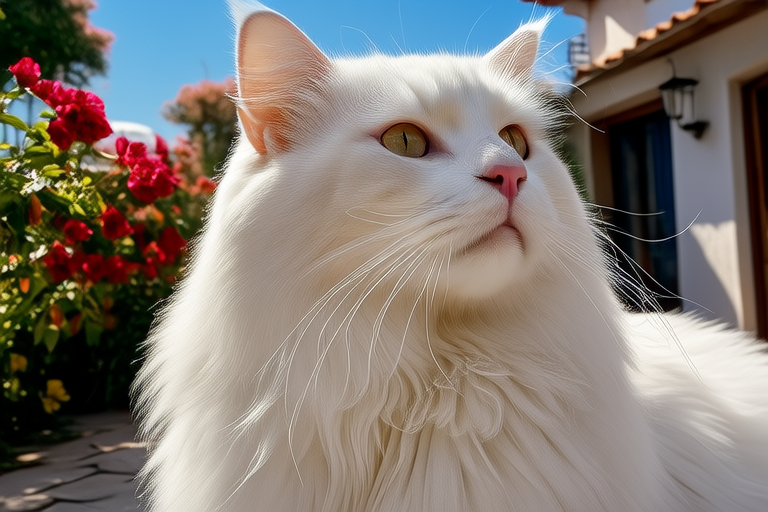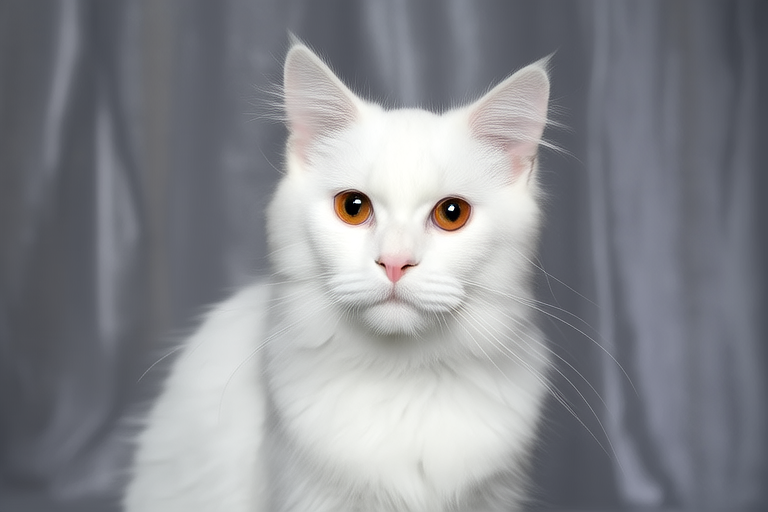
Turkish Angora: Beyond the Silky Coat
The Turkish Angora is a breed of cat that has captivated the hearts of many with its elegant appearance and graceful demeanor. While it is widely recognized for its luxurious, silky coat, this breed possesses a myriad of unique traits that make it a fascinating companion. From its storied origins to its distinctive physical attributes, this article delves into the world of the Turkish Angora, offering insights that go beyond its renowned fur.
Historical Origins
The Turkish Angora traces its roots back to ancient times, with evidence suggesting its presence in Turkey as early as the 16th century. These cats were revered by the Ottoman Empire, often being kept in harems and presented as gifts to visiting dignitaries. The breed’s name reflects its origins, with “Angora” referring to the city of Ankara (formerly known as Angora) in central Turkey. Interestingly, the Turkish Angora shares a common ancestry with the Persian cat, both descending from long-haired felines native to the region.
During the 17th century, Turkish Angoras were introduced to Europe, where they gained popularity among aristocrats. However, the breed nearly faced extinction due to interbreeding with other domestic cats. It was not until the 20th century that efforts to preserve the Turkish Angora began in earnest. Today, the breed is recognized by various cat registries, including the Cat Fanciers’ Association (CFA), The International Cat Association (TICA), and the Fédération Internationale Féline (FIFe).
Distinctive Physical Characteristics
Beyond their famous silky coats, Turkish Angoras exhibit several distinctive physical features that set them apart from other breeds. They possess a slender yet muscular build, giving them a graceful and athletic appearance. Their legs are long and slender, while their bodies are medium-sized but well-proportioned. Turkish Angoras have large, expressive eyes that can be blue, green, gold, or a combination of colors, depending on their genetic makeup.
Their ears are large and tufted, adding to their alert and curious expression. The Turkish Angora’s tail is long and plumed, often featuring a distinctive white tip. Their coats come in a variety of colors, including solid white, black, red, and tabby patterns. The most sought-after color is the pure white coat, which is associated with the breed’s royal heritage. Despite their silky appearance, Turkish Angoras have short undercoats, making them less prone to matting than some other long-haired breeds.
Temperament
Turkish Angoras are known for their playful and affectionate nature, making them excellent companions for families and individuals alike. They are highly intelligent and curious, often displaying a keen interest in their surroundings. This curiosity can lead to a tendency to explore and investigate new objects, so owners should provide plenty of stimulating toys and activities to keep their cats engaged.
Despite their playful nature, Turkish Angoras are also known for their loyalty and devotion to their human companions. They enjoy spending time with their owners, often following them around the house and seeking attention. While they can be independent, Turkish Angoras generally thrive in households where they receive regular interaction and affection. They are not overly demanding but do appreciate consistent attention and care.
Adaptability to Different Environments
Turkish Angoras are adaptable to a wide range of living conditions, making them suitable for various environments. They are equally comfortable in urban apartments as they are in rural settings. However, they do require sufficient space to move around and engage in their natural behaviors. Owners should provide scratching posts, climbing trees, and other enrichment items to ensure their cats have ample opportunities for exercise and play.
These cats are generally good with children and other pets when properly socialized. They tend to get along well with dogs and other cats, provided they are introduced gradually and given time to adjust. Turkish Angoras are also known for their ability to coexist peacefully with birds and small animals, making them a versatile choice for households with diverse pet populations.
Vocal Communication Styles
Turkish Angoras are known for their vocal communication styles, often engaging in conversations with their human companions. They are not typically loud or incessant in their meowing, but they do have a distinct voice that is soft and melodious. Turkish Angoras may meow to express their needs, seek attention, or simply engage in conversation. Some owners describe their cats’ voices as musical, adding to the breed’s charm.
While they are not as talkative as some other breeds, such as the Siamese, Turkish Angoras are still capable of conveying their emotions through vocalization. They may purr contentedly when stroked or knead with their paws to show affection. Additionally, they may chirp or trill when excited or playing, further enriching their interactions with their owners.
Grooming Needs
Despite their luxurious coats, Turkish Angoras require relatively low maintenance when it comes to grooming. Their short undercoats mean they are less prone to matting than some other long-haired breeds. Weekly brushing is usually sufficient to remove loose hair and prevent tangles. During shedding seasons, more frequent brushing may be necessary to manage excess fur.
Owners should also pay attention to their cats’ dental hygiene, trimming their nails regularly, and checking their ears for signs of infection. Regular grooming sessions provide an opportunity for owners to bond with their cats and monitor their overall health. Additionally, Turkish Angoras benefit from regular bathing, though it should be done sparingly to avoid stripping their skin of essential oils.
Health Considerations
Turkish Angoras are generally healthy cats with few breed-specific health issues. However, like all breeds, they are susceptible to certain conditions that owners should be aware of. One of the most notable health concerns for Turkish Angoras is hypertrophic cardiomyopathy (HCM), a condition that affects the heart muscle. Early detection and management of HCM can significantly improve a cat’s quality of life.
Another consideration is the breed’s susceptibility to obesity, particularly if they are not provided with adequate exercise. Obesity can lead to a variety of health problems, including diabetes and joint issues. Owners should ensure their cats maintain a healthy weight through proper diet and regular physical activity. Additionally, Turkish Angoras may be prone to dental disease, so regular dental care is essential to prevent complications.
Lesser-Known Facts About Intelligence and Behaviors
Turkish Angoras are highly intelligent cats, often displaying problem-solving abilities that can surprise even their owners. They are quick learners and can be trained to perform simple tricks or respond to commands. Some owners report that their Turkish Angoras can open doors or cabinets, demonstrating their dexterity and curiosity.
In addition to their intelligence, Turkish Angoras are known for their playful and energetic nature. They enjoy games that involve chasing and pouncing, and they may spend hours engaging in interactive play with their owners. Their agility and athleticism make them excellent climbers and jumpers, allowing them to reach high places with ease. Turkish Angoras are also known for their love of water, often showing interest in watching or playing with running water.
One lesser-known fact about Turkish Angoras is their ability to adapt to various environmental changes. They are resilient cats that can thrive in different climates and living situations. Whether in a bustling city apartment or a quiet countryside home, Turkish Angoras can find ways to make themselves comfortable and content. Their adaptability makes them a versatile choice for pet owners who may face changes in their living arrangements.
Conclusion
The Turkish Angora is a breed of cat that offers much more than just its famous silky coat. From its storied origins to its distinctive physical characteristics, this breed is a true marvel of nature. With their playful and affectionate nature, adaptability to different environments, and unique vocal communication styles, Turkish Angoras make excellent companions for those seeking a loving and intelligent feline friend.
While they require minimal grooming and are generally healthy, owners should be mindful of potential health concerns and provide appropriate care. By understanding and appreciating the unique traits of the Turkish Angora, potential owners can ensure a fulfilling and rewarding relationship with these magnificent cats.






